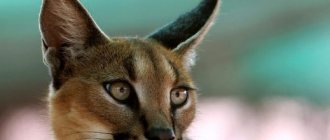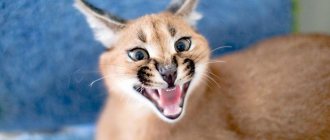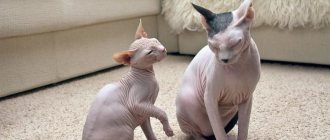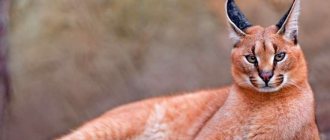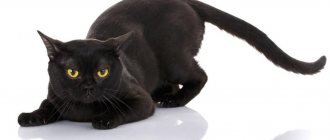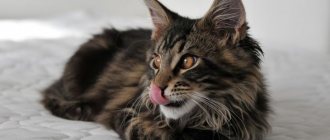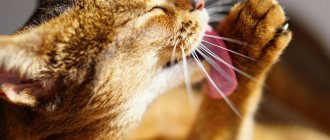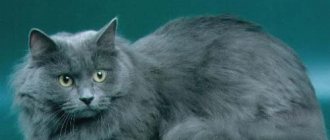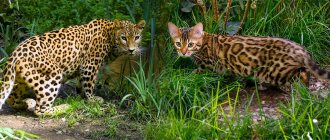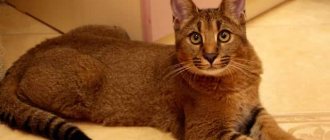How and where to buy a caracal kitten
First of all, you need to take a responsible approach to choosing a nursery.
It must be officially registered so that upon purchase you will be given all the necessary documents. Purchasing from resellers or poachers will create problems for both the owner and the pet - at least when contacting a veterinarian. Before purchasing, visit the nursery and see in what conditions the animals are kept, whether they receive regular food and the opportunity to walk. In this regard, a home nursery is better than an enclosure, because from birth the kitten is in contact with a person, and therefore feels the need for him and, on the other hand, will more easily survive a change of environment.
The reliability of the breeder does not replace the inspection procedure. Examine the kittens carefully. If the kitten is healthy, it has shiny fur, clean ears, eyes and nose. The discharge should alert you. Observe how the kittens play and how they react to humans. An active, friendly caracal is likely to be the right choice.
The cost of a kitten in our country is $8,500-12,000. It depends on whether you are purchasing a purebred caracal for breeding or not. A cat usually costs more than a female cat. The high price is explained both by the difficulty of cultivation and by the fact that breeding caracals in our country has not yet gained popularity. But for those who have decided to make such a purchase and follow the advice of professionals, the handsome black-eared dog will bring many pleasant moments.
Photo gallery of caracals:
What does the price depend on?
The cost of any animal, especially exotic and large ones, is always high. When it comes to lynx, its final price is influenced by several important factors:
- place of purchase - from breeders who monitor the health, nutrition, purity of the blood of their inhabitants, the price will always be much more expensive than if you buy an animal from your own hands;
- age of the individual - small “kittens” are valued a little less than already grown, fed lynxes for 2-3 months;
- belonging to a species - individuals with typical species characteristics are more valuable than crossed varieties;
- uniqueness - lynxes with unusual appearance features are more expensive.
Appearance
Externally, the caracal animal closely resembles a lynx. But at the same time, its size is much smaller, its color is monochromatic, and its overall physique is more graceful and slender. The body reaches a length of 65-80 centimeters, and the tail – up to 30 centimeters. At the withers, large individuals can have a height of up to 45 centimeters and weigh 15-20 kilograms.
The ears are so long that they appear disproportionately large on juveniles. They have a long tassel at the ends - up to 5 centimeters. The paws are covered with brush - hard, short hair makes running on cold and hot sand much easier.
In general, the fur is thick and short. On the one hand, this avoids problems with sand getting into the skin. On the other hand, it perfectly protects not only from the wind, but also from high temperatures, which are often observed in the steppe and desert. The color of the fur is uniform - reddish-brown or sandy on top, and white on the bottom. Black markings are visible on the muzzle. The ears (outside) and tassels are also black. In addition, in the wild you can see melanistic caracals - they are black in color, but are extremely rare.
Caracal protection
The African population of caracals is described in Appendix II of CUTEC, but the Asian populations are described in Appendix I of CUTEC. In this regard, hunting such animals is prohibited in many countries in Asia, as well as Africa. As for the Namibian and South African populations, caracal hunting is permitted here only to protect livestock.
In addition, it is believed that these predatory animals are on the verge of extinction in other countries, such as Pakistan, Jordan, and northern Africa. However, populations are at a stable level in southern and central Africa. The caracal trade is practiced in many countries around the world. Here they are kept as pets. These are countries such as the USA, Russia, Canada and the Netherlands. Although the scale of trade is quite small, there is a tendency that the scale of trade in these animals may increase.
Caracals have been listed as Least Concern by the IUCN since 2002. This animal lives in 50 countries around the world where there are no threats to the continued existence of these predators. Naturally, trends in human development are increasingly negative for living nature. The number of people living on our Planet is increasing, so the intensity of their interference in the natural environment is increasing, which negatively affects its inhabitants.
How much does a domestic lynx cost and where to buy it?
There are representatives in the cat world that are difficult to take your eyes off when you see them, and besides, it is quite possible to keep them at home. Such exotics include the domestic lynx, or kakarala. Nature has endowed this animal with unique beauty, grace, majesty and other features. Of course, sometimes some difficulties arise with unusual kittens, but if you decide to adopt a cat from the wild, you should be prepared for this step. Therefore, before you get yourself an extraordinary pet, it is advisable to get to know it better: what are its habits, how to care for it, what to feed it, how much it costs.
Population and species status
To date, there is no accurate data on the number of caracals in the wild, so it is almost impossible to give an accurate assessment of the population status of these living creatures. In Asia and northern Africa, these predators are considered rare, but in the south and center of the African continent, caracals are considered problem animals, so they can be hunted at any time of the day or night. Ranchers sometimes leave behind poisoned animal carcasses, which kills many predators.
In South Africa, an average of 2,200 caracals were killed between 1931 and 1952, while in Namibia almost 3 thousand individuals were killed in 1981 alone.
To protect their livestock, local residents of many countries thoughtlessly destroy these animals. They are also caught and traded in the Arabian Peninsula. Many animals die in road accidents.
Description and photo
There are quite a few species of caracals that are found in the wild in the steppe and desert regions of Turkey, Africa, Turkmenistan, India, Iran, some regions of Uzbekistan and the Dagestan foothills. At the moment, scientists have identified 9 varieties of this predatory animal, but for people who are not interested in such a small lynx, there will be no significant difference between them.
Most of the subspecies are found in Africa, where the animals do not require protection and local hunters willingly arrange safaris for them, luring them to themselves with the help of special technical devices (for example, emitting cries of wounded animals).
At the same time, in Asian countries, the population of caracal subspecies is decreasing more and more every year and they are included in the local Red Book (for example, there are only about 300 individuals of Turkmen caracals left).
If you want to get an exotic animal, then before doing so, be sure to take into account all the nuances of keeping such pets as a lemur, newt, raccoon, hedgehog, crocodile, turtle, iguana, leopard gecko, chameleon, jerboa, squirrel, chipmunk, weasel and mini-pig.
Appearance
Whatever variety your domestic steppe lynx belongs to, it will be quite tall (sometimes up to 50 cm at the withers), graceful animal, with graceful body contours. Such pets have an elongated head, with long ears located on it, at the end of which there are tassels of fur.
There is a fairly large distance between the vertically standing ears, as if constantly listening. On the back side, their color is pure black or with a slight graying. True, animals living in Namibia have white ears.
The entire body of the caracal is covered with thick and short fur, and on the hind legs it is relatively stiffer, which in natural conditions allows such a cat to easily move on sandy surfaces. On the chest and belly, the fur is slightly longer, and as for color, depending on the type of predator, there are both “sand” and brown animals, with lighter areas on the belly, chest and inside of the paws.
Did you know? In South Africa, specially trained caracals work alongside people at military airports, where their duties include clearing birds from runways.
The dark areas characteristic of an ordinary lynx are present on the belly and face of the caracal, and under the eyes it is easy to notice a yellow stripe. There are no differences in coat color between females and males. The tail is shorter than the tucked body by about ½ of its length, which, in combination with long, dry limbs, sometimes looks very funny. The paws are quite massive.
It is worth noting that females are always smaller than males, whose weight often reaches 30 kg, with a height of 45-50 cm. In contrast, the female representatives weigh mainly about 15-20 kg. An adult has a fairly long body, often reaching 60-90 cm, with a tail length of approximately 35 cm.
Simply put, according to all external data, a caracal is a smaller copy of an ordinary lynx, differing from it in greater grace and the uniform color of its coat.
Character
Surely there are many skeptics who doubt the possibility of keeping such an animal at home, but as the practice of many caracal owners shows, their character is not much different from the character of an ordinary domestic cat, and in some cases such a wild pet will be even more gentle and docile.
With proper upbringing, mini-lynxes are characterized by increased curiosity, playfulness, kindness and good learning ability. Unlike ordinary cats, caracals have a high level of devotion, which makes them similar to dogs, and they are even able to fetch toys while playing.
Caracals are distinguished by the presence of a “master instinct” and will always jealously guard their possessions from the invasion of other animals, although if a kitten grows up with a cat or dog from childhood, then there should be no problems. The only ones that should be hidden away from the tenacious claws of a domestic predator are decorative rodents, which the caracal is accustomed to feeding on in natural conditions.
Norwegian Forest Cat: Description
The Norwegian Forest Cat is a giant with a gentle character. This breed is similar to Maine Coons due to their lush coat, impressive size and variety of colors, but the roots of these breeds are different. We can say that the first representatives of this breed appeared by chance, as a result of the mating of a domestic “spring” cat with a wild cat from the Norwegian forest. When the cat gave birth, people assessed, first of all, the hunting abilities of the grown kittens.
So they began to work on the breed purposefully. The result was large animals with a restrained, calm character, independent, but attached to home and people. These cats have a very strong psyche, adapt perfectly to any situation, and therefore are even able to travel with their owner.
Norwegian forest cat
The breed is characterized by thick wool with a dense undercoat, which protects the animal from any weather. A person looking at a Norwegian cat gets the impression of power and wild, primitive strength hidden under the gentle and gentle appearance. Indeed, modern “Norwegians” have retained all the qualities of hunters, and, if necessary, are able to defend themselves even from a large dog.
Cat breeds similar to lynx
The group of cats with tassels includes several breeds . Even the Neva Masquerade can acquire similar decoration.
Felinologists are confident that this is how the genes of our ancestors manifest themselves. The trait is not inherited, but appears randomly, so masquerade cats are not included in this group.
Caracal
Caracal is an oriental beauty with a wild and affectionate disposition . A mysterious, spectacular, graceful cat with a charming look will not leave anyone indifferent.
Most of the animals live in the wild . Domesticated individuals are rarely found.
This is an ancient species of cats living in Asia Minor and Central Asia , in the steppes and deserts of Africa, and in the Middle East. It is less common in Kyrgyzstan, Turkmenistan, and Uzbekistan; about 100 individuals live in the regions of Dagestan.
The name of the breed comes from the Turkic “kara kylak” , which in translation sounds like “black ear”. The back of the ears and tassels are painted black. The black border also runs along the inner edge of the ear.
Caracal is a cat breed similar to a lynx, distinguished by its large size : height at the withers 45-50 cm in height, body length 80 cm, tail length 30 cm. The body is strong, muscular, proportional, the paws are strong and long, covered with short, hard hair. The muzzle is elongated, wedge-shaped, the eyes are large, expressive, the ears are long, decorated with black tassels. Life expectancy is 15-18 years.
The wild caracal is a ferocious and unapproachable hunter, lightning fast, stealthy and strong. The domestic caracal is an affectionate and gentle animal, a friend and family pet . An important condition for successful socialization is education with love and respect, without physical punishment.
Caracals have excellent memory and developed intelligence . Cats love to go for walks, spend time with people, and be the center of attention. The representative of the breed is territorial, so stray dogs and cats are not allowed into a private home. The caracal gets along well with other pets, except birds and rodents.
Caracals have excellent health and rarely get sick , living to a ripe old age.
Caraquet
The caraquet is a domestic lynx cat similar to the wild caracal . American breeders tried to cross a domestic caracal with an Abyssinian cat. The experiment was a success. This is how the first hybrids of the second generation were obtained.
The second birth of the Carakets happened in the Russian city of Ivanovo. Breeder Irina Nazarova was inspired by the idea of breeding small wild cats. The crossing involved a young croak and a domestic cat.
Subsequently, representatives of the following breeds were used for breeding: Serengeti, Egyptian Mau, Abyssinian, and Oriental. As a result, the new breed developed distinctive features - large ears, long muzzles, excellent health and fertility.
The appearance of caraquets is colorful - they are quite large animals (9-12 kg) with strong long limbs , a wide nose, large eyes and huge black tufts on the ears. The color is uniform brown-red on the back and sides. A second generation of caracats is planned by crossing with Abyssinians in order to preserve the warm color and ticking.
Cats are completely devoid of aggression and are very sociable.
Important! Caracats cannot be declawed. They are great at retracting them, like many hybrids, so they don’t scratch or damage furniture.
Caracats inherit immunity from caracals, so they do not get sick and are not susceptible to genetic pathologies.
Maine Coon
The Maine Coon is a beloved breed native to Maine, USA. The cats are considered descendants of domestic shorthair cats crossed with Scandinavian cats . Felinologists trace a connection with the Norwegian forest cat.
The ancestral origin of the Maine Coon is unknown and is based on assumptions and legends :
- The breed appeared after the mating of a male cat and a female raccoon . As evidence, they cite the color of the tail, similar to the tail of a raccoon.
- The cats originally belonged to Marie Antoinette and were illegally imported into the United States.
- Maine Coons were created by crossing a North American lynx with a regular cat. The theory is confirmed by the presence of tufts on the ears, like a lynx.
Maine Coon is a cat with ears like a lynx, the breed is extremely large . Males weigh 6-10 kg, females 4-7 kg. The height is 25-41 cm, and the length reaches 120 cm, including the tail - 30-36 cm in length.
The body is strong, muscular, limbs are strong . The body is rectangular. Representatives of the breed mature slowly and reach their potential size by 3-5 years.
Maine Coons are curious by nature, sociable, but not annoying , and do not require special attention from the owner. Cats love to play with puzzle toys, look out the window, don’t mind walking on a leash, and are ready to accompany their owner on trips.
Cats adapt to any type of home , are not afraid of heat or cold, and are friends with dogs and cats.
Life expectancy is 9-15 years with proper care and a balanced diet.
Maine Coons have strong immune systems, but are predisposed to :
- hypertrophic cardiomyopathy;
- hip dysplasia;
- polycystic kidney disease.
Interesting. Maine Coons are silent and rarely meow. They usually “chirp” in high tones or emit melodic trills in a thin voice.
Pixiebob
The Pixie-Bob breed was created by an accidental connection between a cat named Pixie and a wild cat in 1985. The kittens were born tailless, which served as the starting point for the development of the breed. The breed received official recognition by the International Cat Association in 1994, and in 2005 by the American Cat Fanciers Association.
Adult cats are large, reaching 6-8 kg, females - 5-6 kg . Pixiebob is a kind, smart and playful animal that has absorbed the best qualities of cats. These cats are tireless participants in games, faithful travel companions, faithful friends and full members of the family.
The physique is massive, the chest is pronounced, the legs are short . The muzzle is wedge-shaped, the ears are of medium length. The coat pattern is striped. Life expectancy is 15-17 years.
Pixie-bob is an interesting breed of cat, like a lynx, which is distinguished by high intelligence and patience . These are soft and kind cats, adventurers by nature. They love to watch their owners' daily household activities - cooking, washing, cleaning. Pixiebobs normally perceive changes in situation and environment, are excellent at navigating the terrain, and have developed hunting instincts.
Representatives of the breed are generally healthy and not prone to genetic pathologies , despite the fixed short-tailed gene. Cats tend to be overweight, so they should not be overfed.
Interesting things on the site:
13 Largest Cat Breeds in the World
A cat like a leopard - what kind of breed is it?
Norwegian Forest Cat
It is not known exactly how the Norwegian forest cat appeared : either the Scandinavian goddess Freya cut through the clouds in a chariot drawn by six cats, or the animals appeared as a result of meetings between the Vikings and the Turks. If you believe the second theory, then the ancestor of the beautiful “Norwegian” should have been an Angora cat. There is another variant of origin - from a Siberian cat. In any case, the breed is ancient, indigenous, and developed in natural Scandinavia.
The harsh climate forced the animals to acquire warm, thick and long fur coats with dense undercoat, which allows them to withstand rain, snow and wind.
In the 30s XX century a group of European breeders set about creating a full-fledged breed with characteristic features. We didn’t think about the name of the breed for a long time. In their homeland, cats are called “Norsk Skaukatt”. Several individuals from the Norwegian Cat Fanciers Club participated in the exhibition in Oslo. The animals were received well and given high scores.
At the beginning of World War II, the breeding program was suspended and, unfortunately, most of the population became extinct. It took 40 years for breeders to become interested in Norwegian cats again. The breed received official recognition in 1993.
The Norwegian Forest Cat has a large build, long hind legs, a developed chest and muscles , and long ears with tufts. Animals can climb trees and hunt. In addition, they lead the lifestyle of an ordinary cat - bask in the sun, chew grass on the lawn, play with children.
The Norwegian cat has a stable and balanced character and a sharp mind . They are ready to give affection and warmth to all family members; they love to sit on laps and lie next to the owner.
Life expectancy is 12-16 years. The breed has strong immunity, but is prone to genetic diseases :
- accumulation of glycogen IV;
- hypertrophic cardiomyopathy;
- retinal dysplasiaNo.
- polycystic kidney disease.
Interesting. In Norway, cats are called "skogkatts", which translates as "forest cat".
Chausie
Chausie or Hausie is an unusual breed, a cross between the wild jungle cat Felis Chaus and the Abyssinian cat .
Crossing with a wild cat determines the cost of the breed - from 10 thousand US dollars. The breed is classified into 4 stages F1-F4 . The higher the number, the higher the percentage of wild blood. Kittens of the F1 group are obtained directly from crossing a jungle cat and an Abyssinian, F4 are no different in size from ordinary cats and have the maximum level of socialization.
These animals are large in size . The weight of males reaches 7-10 kg, females - 7-9 kg, and body length - 1 m. There are three types of colors - black, silver (ticked), tabby. The tip of the tail is invariably black. Elongated ears are decorated with tassels. The body is strong and flexible, the animals skillfully climb trees and make amazing jumps.
Chausie is a temperamental cat that cannot stand loneliness and prefers the company of its owner . Cats marked F3 and F4 are more suitable for home keeping, but in any case, animals will feel more comfortable in a private home with the possibility of free walking.
Chausies have retained the hunter's instinct; they are not afraid of water and swim skillfully . Cats get along well with dogs and other cats, but birds and fish are potential victims for them.
Some individuals have difficulty establishing contact with children due to innate aggression. They will not allow familiar or brutal treatment and extend their claws for protection.
Chausies have excellent health, they rarely suffer from infectious diseases and are not predisposed to genetic ones.
Kurilian Bobtail
The Kurilian Bobtail is a rare breed of cat originally from the Kuril Islands. By default, the breed is considered Russian . Outside of Japan and the Russian Federation, the Kurilian Bobtail is rare.
There are two varieties of the breed - short-haired and long-haired. The shorthaired bobtail was first registered 200 years ago in the Kuril Islands. Long-haired cats appeared later.
A distinctive feature of the breed is a short tail 5-13 cm long . The physique is massive, the body is strong, inclined forward, the paws are proportionally developed, the neck is of medium length, the head is wedge-shaped, large eyes, medium-sized ears.
The Kurilian Bobtail is a breed that never gets boring. This is a playful, smart, kind animal . Many qualities that appeared as a result of natural selection have been preserved to this day thanks to strong genes. Cats skillfully fish, swim freely, hunt well, and have an inquisitive and free character. They are affectionate and loving, quickly becoming attached to people.
The Kurilian Bobtail has excellent health and rarely gets sick . The gene responsible for the short tail does not cause genetic abnormalities. However, cats tend to be overweight, so it is important to control the quality and quantity of food.
Pixie bob: mini lynx for the home
A wonderful domestic breed that is most similar to the lynx when it comes to tame and affectionate cats. This artificially bred breed is the fruit of the successful work of specialists from the USA. Pixie bob translates to “elf with a short tail.”
The first kittens were born in the 80s of the last century, from a domestic pet and a wild forest cat with a short tail. The breed's characteristics, such as a pear-shaped head, a spotted coat, and powerful “whiskers” like a real lynx, were fixed over several more generations, and the pixie-bob became incredibly popular.
The pixie bob also has tassels on his ears.
The standard breed characteristics of pixies are:
- The head is large, strong, the chin is wide and powerful.
- The ears are rounded, large, with tassels at the tips (there are individuals without them).
- “Heavy” wide eyes, pronounced brow arches, eyelids drooping, creating a stern look.
- Pixie-bob kittens have sky-blue eyes from birth; by six months the iris color changes to hazel, honey or green.
- The mirror of the large nose has a brown tint, the nose itself has a slight hump.
- The physique is powerful and heavy; the weight of an adult animal can reach ten kilograms.
- Wild ancestors “gave” the pixie-bob limbs of different lengths - the hind ones are higher than the front ones.
- The pixie still has a tail - it is desirable that it be five to seven centimeters in length and slightly “broken”.
- The pixie-bob has brown fur and characteristic spots; hairs are shorter on the body and longer on the belly.
Domestic cat with wild charm
Despite the fact that pixie bobs are strikingly similar to absolutely wild cats, they are very affectionate towards humans, have a balanced and even phlegmatic character, and are strongly attached to their family. It is the combination of appearance and docileness that makes the pixie a very common and popular breed abroad. In Russia, cat lovers are just getting acquainted with pixies.
How much does a live domestic lynx cost in Russia?
There are many species of wild cat. Let's look at the prices for the main ones.
- Red lynx, or red – 50 thousand rubles.
- Canadian – 40 thousand rubles.
- Ordinary – 100 thousand rubles.
- Pyrenean, or Spanish - it is not possible to buy legally, as it is listed in position 1 of CITES.
Meanwhile, wild species are difficult to domesticate. Thanks to crossbreeding, breeds have been developed that are characterized by a gentle disposition and good tamability. Naturally, this could not but affect the price aspect.
- Steppe lynx, or caracal – 400 thousand rubles. Due to the noticeable external similarity, this animal was classified as a lynx species, but today it belongs to a separate genus. If raised correctly, these kittens turn into playful and friendly adult pets.
- Karaket – from 850 thousand to 1 million rubles. This species was the result of mixing a domestic cat with a caracal. This is a rather peaceful, friendly breed, sometimes very independent, but not at all aggressive. A hybrid belonging to the first generation is more valued, the cost of which often exceeds 1 million rubles. By the way, the caracat is more similar to the lynx.
- Domestic lynx - from 400 thousand to 1 million rubles. These representatives are a cross between a domestic cat and a Canadian lynx. In appearance it is similar to its wild ancestor, but from the domestic cat the lynx got its active character, tenderness and love for humans.
In addition to the presented samples, there are known lynx-like breeds, which are similar to lynxes, but have a different origin. An indisputable advantage is the relatively low cost coupled with domestication.
Keeping such pets does not require a huge amount of space, and there are no risks associated with living with a wild animal. For how many rubles you can purchase such representatives, we will consider further.
- Siberian cat – from 7 to 15 thousand rubles. This little beauty was the result of a love for wild cats that lived in the Trans-Urals and oriental breeds. The thick coat is due to the harsh climate. The tassels on the ears resemble wild relatives. A characteristic feature of this breed, in addition to its complacent disposition, is attachment to only one owner.
- Norwegian forest - from 12 to 70 thousand rubles. and more. Their large size and powerful stature should not frighten you, because these Norwegian cats have a kind and reserved disposition. By the way, they are ready to get along with noisy children and with other tribesmen, for example, with dogs.
- Pixie bob – from 30 to 100 thousand rubles. This breed is quite young and rare. These cats have a canine character, are very smart, and calm. They tolerate change negatively, and without human contact they can quickly become wild.
- Maine Coon - from 20 to 80 thousand rubles. One version says that such pets were the result of mating between an ordinary cat and a North American lynx.
- Kurilian bobtail – from 15 to 70 thousand rubles. These wonderful animals were bred on the Kuril Islands. This breed is perfect for someone who is looking for a fun and smart animal.
- American bobtail – from 35 to 90 thousand rubles. This species is very loving, characterized by ingenuity and intelligence. For example, these cats will have no difficulty leaving a closed cage.
Reproduction and young
Both females and males reach sexual maturity by 1 year. However, successful mating occurs a little later, when the animals reach 12-15 months. The mating season lasts all year round. Females go into estrus for 1-3 days, and continue every 2 weeks until the female becomes pregnant. During the period of estrus, the female attracts males with urine marks, then, upon seeing the male, the female lies down on the ground. During the mating period, animals form temporary pairs, but immediately after mating these unions disintegrate.
The female's pregnancy lasts from 2 to 3 months. In a litter, from 1 to 6 kittens are born. Peak birth rates occur between October and February. Females give birth in cover of dense vegetation, or in abandoned aardvark or porcupine dens. Moreover, even before the birth of the cubs, the female prepares several shelters in order to drag the kittens in the future from place to place.
Caracal kittens are born blind, with drooping ears and, unlike adults, cannot retract their claws. The color of a kitten is similar to the color of an adult animal, differing only in the spots on the abdomen of the cubs. The eyes open on the 10th day, and at first the kittens have blue eyes. By 3-4 weeks, kittens learn to retract their claws and their ears become erect. At this time, the cubs actively explore the den, and the female has to change the location of the shelter almost every day.
From 1.5 months, the cubs begin to eat meat and actively play with each other. At 3 months, kittens already go hunting. Milk teeth grow in 50 days, molars by 10 months. At 9-10 months, young caracals gradually leave their mother, although young females stay with their mother longer.
Description of the breed
Description of the external features of the Caracal cat:
- the head is small in size with an elongated muzzle with white and dark spots;
- large ears set high, black in color, tasseled at the tips;
- the eyes are almond-shaped, yellowish in color, edged with a black stripe;
- the body is muscular, slender, 65-85 cm long;
- height at withers about half a meter;
- paws are slender, of medium length;
- the coat is short, dense, thick;
- the tail is movable and long.
Caracals are very similar in appearance to steppe lynxes, so they are sometimes mistakenly classified as this type of animal. But that's not true. The cat lives in the African, hot jungle in the center and south of the country. Unfortunately, local residents consider it a pest, and you will no longer see the caracal in the northern territories.
Individuals get along well with servals, but their “friendship” with cheetahs is a thing of the past. Caracals live on the outskirts of forests, which smoothly merge with the plains. These cats are very unpretentious, but, nevertheless, avoid desert areas with arid climates. A remarkable external feature of caracals is their large, pointed ears, which bend slightly under the weight of their charming black tassels. Cats can be different shades of brown. Their body underneath is light colored with small spots.
The body is powerful, flexible, graceful and muscular. The caracal is simply excellent at jumping. Taking off from the ground, he flies in a jump for several seconds, covering 4.5 meters. The length of these amazing cats is from 60 cm to 1 meter, although females are slightly smaller in size than males. The weight of cats belonging to this breed sometimes reaches 20 kg.
Wild animals
Lynxes and caracals are brave, skillful and determined hunters.
Lynx
The common lynx is the northernmost of all felines: it can be found even beyond the Arctic Circle. The range is wide: the animal lives in Russia, Norway, Sweden and Finland, in some regions of Central Asia and Transcaucasia, almost throughout the entire territory of the Carpathians, etc. Previously exterminated populations have been restored in Germany, Switzerland and France. In some countries this animal is endangered, in others it is quite common.
Appearance
The body is dense and short. The body length is from 80 to 130 cm, the height at the withers is about 70 cm. Adult males weigh 18–25 kg, rare individuals - up to 30 kg. The average weight of females is 18 kg.
The lynx's long legs and wide paws help it move easily through the snow.
The tail is short (20–40 cm), thick, and looks chopped off. The legs are long. The paws themselves are wide, and in winter they are overgrown with long hair, which distributes the load like skis and reduces the risk of falling into a snowdrift.
The head is rounded, the muzzle is short. The most recognizable feature of the lynx is the long tufts on the tips of its ears and its distinctive “whiskers.”
The coat is silky, the thickest and longest among cats: on average 5 cm, on the stomach up to 7 cm. The color is usually spotted, the shade depends on the region of residence and the variety. It can be from reddish-brown to smoky. The fur on the belly is lighter.
Lifestyle
Lynxes mainly hunt hares. Large birds and rodents, including beavers, small ungulates such as fallow deer and roe deer, and young wild boars and moose, can also become their prey. Lynxes often kill competitors - foxes and martens, even if they are not hungry. They compete with wolverines for prey with varying degrees of success. Domestic dogs and cats can be attacked near human habitation.
Contrary to popular myth, they jump on prey not from a tree, but from a ground ambush. They can also hide game, that is, get as close as possible to attack, hiding behind cover. The rest of the distance is covered with long, up to 4 m, jumps. If the first attack was unsuccessful, they pursue for another 60–80 m, but most often without success, because they quickly run out of steam.
If the prey was large, the remainder is buried with snow or earth, and they try to stay nearby until it is completely eaten.
The mating season begins in winter or spring depending on the region. There are usually 2–3 kittens in a litter, occasionally 4–5.
The “smiling” expression of the muzzle gives lynxes special charisma.
Life expectancy is 15–20 years.
A man-eating lynx pursuing a party of geologists or gold miners is a popular motif in adventure literature set in the north. However, in fact, there is not a single documented case of such a targeted hunt: an animal can maim a person only in case of self-defense, for example, after falling into a trap, if it is guarding young animals or is infected with rabies.
Lynxes, even adults, are relatively easy to tame; many allow themselves to be taken into hand. Like domestic cats, they express their pleasure by purring loudly. However, we must not forget that these are still wild animals - it is precisely when kept at home that lynxes sometimes attack their owners.
Photo gallery: lynxes in nature
The lynx takes care of its offspring for a little less than a year. Before the decisive jump, the lynx tries to get as close to the victim as possible. The warm, thick fur of the lynx reliably protects it from the cold
Caracal
Thanks to the tufts on its ears, this animal is also called the steppe lynx. The caracal is separated into a separate genus, but is related to real lynxes, similar to pumas and servals. It interbreeds well with the latter in captivity. Most of the population lives in Africa, Asia Minor and Central Asia, and the Middle East. The caracal is listed in the Red Book, but is considered one of the least endangered species.
Appearance
Height at the withers is up to 45 cm, body length is 65–82 cm, tail length is 25–30 cm. Average weight is from 11 to 20 kg.
The fur is thick and short. On its paws it forms a kind of brush, making it easier to walk on the sand. The color is red-brown or sandy, the bottom of the body is lighter. The outer part of the ears and tassels are black. Melanists are rare.
Due to the large mobile ears with tassels and dark markings on the face, the caracal looks very impressive
Lifestyle
The caracal mainly hunts rodents, hares, and reptiles. Sometimes flying birds are enough to attack young ostriches and small ungulates. Near human habitation, it often steals poultry, goats and lambs. Attacks other predators: foxes and mongooses.
Stealths prey, then overtakes it with jumps of up to 4.5 m. It drags large game into trees to protect it from competitors. It can go for a long time without drinking - it receives the required amount of liquid from the blood of its victims.
The breeding season does not depend on the time of year. There are 1–6 cubs in a litter. Until the kittens are one month old, the female carries them from one den to another every day. They become independent at 6 months.
Like lynxes, caracals are easily tamed. At one time in India and Persia they hunted hares, small antelopes and pheasants with them. These days, these animals are sometimes used to drive birds away from airfield runways.
Video: caracal - steppe lynx
Pros and cons of caracals
Like any cat breed, the caracal has a considerable list of advantages and disadvantages, which, before bringing this exotic cat home, it is important for its future owner to become familiar with in great detail. Advantages:
Advantages:
- Unusual and exotic appearance;
- Excellent health and strong immunity, resistance to most common cat diseases;
- A dog's devotion to its owner;
- The ability of kittens to quickly adapt to a new home;
- Playfulness, activity, curiosity;
- Love for affection and attention;
- Love of freedom, but at the same time hassle-free training for walking on a leash.
Flaws:
- Wild disposition and specific character;
- Very high price;
- Very expensive maintenance;
- Procurement is problematic due to the large number of poachers and illegal nurseries who lower the price and do not provide documents;
- Due to the love of freedom and character, the animal is not suitable for apartment housing (only a private house with a yard or enclosure);
- It is strictly not recommended for families with children under five years of age;
- It is practically impossible to train, which is why some owners have difficulty teaching their pet to the tray.
Despite the very high price, the caracal is becoming increasingly popular among lovers of exotic animals. According to statistics kept in the largest nurseries, more and more caracal kittens are purchased from year to year. At the same time, the share of private owners is steadily growing.
Character traits
will remain a predator
When raising such a kitten, you need to maintain consistency and clearly express your requirements, without rushing to teach him everything he needs. Help your pet understand what subordination is and develop rules of behavior in your home.
Key character traits of the caracal that are noticeable even in kittens:
- Balance - these kittens will not surprise you with sudden bursts of activity and then rest for half a day.
- Kindness - the nature of the animals is very soft, here they are in many ways similar to domestic cats.
- Energy - you need to let kittens splash out their energy, otherwise they can direct it in the wrong direction.
- Love of games - kittens will happily play with children.
- Owner's instinct - cats of this breed, regardless of age, will jealously protect their home from other animals. However, they will find a common language with other pets who live with them.
- Curiosity - Caracal kittens want to know everything and always be the first so where something new has appeared or something has happened. They immediately run to the door when the bell rings or to the bushes as soon as they move.
Features of choosing a caracal kitten
to a home-type nursery
Remember the following when purchasing: if you do not plan to breed caracals in the future, then it is advisable to spay or neuter the animal. When the kittens grow up, they will stubbornly mark their territory, causing you constant trouble and discomfort.
Before purchasing a kitten, carefully study what it looks like.
You need to pay attention to the following:
- the kitten's fur was shiny and thick;
- the skin should not peel or have rashes and it should also be clean;
- there should be no unpleasant odor or oozing from the eyes, nose or ears.
If you decide to buy
When purchasing a lynx from nurseries, workers will check your living conditions. Wild lynx and larger breeds require large areas, preferably an enclosure. Some rare, expensive breeds can only be purchased secondhand. If the generation is capable of reproduction, then the cost will be an order of magnitude higher.
The Saltykovsky animal farm is the only place where you can buy wild lynx, located not far from Moscow. Specially bred hybrids are easier to purchase. Nurseries that breed them are usually located in large cities: Moscow, St. Petersburg, Novosibirsk, Vladivostok, etc.
Lynx-like species are easy to buy secondhand in almost all cities. Many people are engaged in breeding and are happy to sell their pets with all the documentation and pedigree.
Source
Interesting facts about caracals
- Black caracals are very rare in nature. Black kittens are born in the same litter with cubs of the usual red color, and the black color is due to a genetic mutation.
- Newborn caracal kittens have bright blue eyes.
- Chinese emperors gave caracals as gifts.
- In the 13th and 14th centuries, the Mongol khans of the Yuan Empire actively bought caracals, tigers and cheetahs from Muslim merchants. The rulers of the Ming Empire, which replaced the Yuan Empire, did the same.
- Until the beginning of the 20th century, Indian maharajas actively used caracals in the game of hunting small game. The predator was launched into a flock of pigeons, and then spectators made bets on which cat would catch the most birds within the allotted time.
- In Asia, tame caracals were often used to hunt hares, peacocks, pheasants and small antelopes. Unlike the expensive hunting cheetah, which was available only to the elite segments of society, the tame caracal was a cheetah for the poor; even poor people could keep it.
- In ancient Egypt, the caracal was a sacred animal. Animal statues guarded the tombs of the pharaohs. During excavations, numerous bronze figurines and drawings of a predator were found, and even embalmed animal mummies.
Caracal 5 (100%) votes: 1
Population and protection of the species
The caracal has been listed as a species of least concern on the Red Book since 2002. Since the animal lives in 50 countries, the status of the population in different regions varies greatly. In North Africa, the predator has now been practically exterminated. In Pakistan, Jordan, Kazakhstan and Uzbekistan, the population is on the verge of complete extinction. A stable population has survived only in southern and central Africa.
Today, caracal hunting is prohibited in the following countries:
- Afghanistan
- Algeria
- Egypt
- Tunisia
- Israel
- India
- Iran
- Pakistan
- Syria
- Tajikistan
- Türkiye
- Turkmenistan
- Morocco
- Kazakhstan
- Libya
- Jordan
What to feed a caracal
This cat is a predator, therefore, it needs protein food. The basis of this cat's diet is meat. Depending on the size, weight, and personal characteristics, an adult pet can eat up to a kilogram of meat products per day. The best options for them are: beef, chicken, turkey, liver. You can boil some of the products, but more is given raw. The meat must contain bones and cartilage, which are needed to train the jaws and supply calcium to the body.
Among caracals there are many lovers of raw eggs and fermented milk products. Should be included in the menu:
- raw sea fish,
- zucchini,
- cabbage,
- pumpkin
The caracal does not need to cook soups or cereals. It is recommended to feed the cat once or twice a day. Uneaten food should be removed. The caracal should go on a hunger strike two days a month. Animals in the wild adhere to this regime.
You can sometimes give your cat dry food. This should be a premium class product intended for breeds: May Coon, Norwegian.
How much does a pet lynx cost?
Depending on the type of animal, its price can vary dramatically.
Common lynx
- Ordinary - 90-100 thousand rubles .
- Canadian - 40 thousand rubles .
- Redhead - 50 thousand rubles .
- Iberian - legal trade is prohibited, and purchase permission is issued only in certain cases.
The listed lynx species are wild and therefore difficult to tame. Several species of animals with a more docile disposition have been artificially bred for domestic breeding. True, this nuance significantly affected their cost.
Caracal
- Caracal (steppe) - 350-400 thousand rubles . With proper care and education, they grow up to be flexible, playful, and kind.
- Home - from 400 thousand to 1 million rubles . A mix of a domestic cat and a Canadian lynx. Outwardly, she is an ordinary wild predator, but her character is like that of an ordinary one. They quickly become attached to a person and remain devoted to him to the end.
Caraquet
- Karaket - from 850 thousand to 1 million rubles . A cross between a domestic cat and a caracal. Peace-loving, independent, no unnecessary aggression, quickly become attached to a person. Typical in appearance is a domestic lynx, the price of which is the highest.
Content Features
The caracal is a freedom-loving animal and requires a spacious enclosure to keep it.
The caracal is definitely not suitable for owners of small apartments. A freedom-loving animal needs a lot of space to satisfy its running needs and not lose its hunting skills.
It is ideal to keep it in a spacious outdoor enclosure, but if this is not possible, then you will have to take your pet for long walks. It’s difficult to predict how the residents of an apartment building will react to such a neighborhood. The mothers in the yard are sure to cackle, worrying about their little ones, and the ubiquitous grandmothers will not give way, but at the same time they will tell you where to go.
The enclosure is equipped with stairs, wooden shelves, stumps, places to rest and other useful accessories that provide the pet with a comfortable existence.
They don’t forget about toys, although ordinary cat toys won’t do – they are fragile and small, so they will either break quickly or be accidentally swallowed, which poses a certain threat to the pet’s life.
It is better to buy large accessories designed for dogs. By the way, toys need to be changed more often - the monotony quickly gets boring.
Origin
In ancient times, some wild cats were domesticated by people. The main purpose of domestication is hunting game. The steppe lynx was one of the first cat breeds that was decided to be domesticated and taught to live among people. The animal is distinguished by high intelligence, flexible mind, but besides this, it is obedient, devoted and loves its owner very much. Richer owners preferred to acquire cheetahs, which are more expensive. A baby caracal cost relatively little money, so people who were not so wealthy chose them as companions.
Trophies of an adult animal:
- hares;
- small ungulates;
- feathered.
Now the wild desert cat often lives in private homes with wealthy owners. This breed is expensive, and a lot of money goes into its maintenance. However, the owners note that the pet, raised from an early age, has a balanced, soft, playful character. The cat is graceful and very beautiful. The breed is especially popular among Arabs and Indians. Noble nobles buy exotic caracals, which always accompany their owners.
Lynx keeping and care at home
The first thing a person who wants to have a wild pet should understand is that the animal needs a place where it will live. The apartment will have to be equipped with a special toilet: a large tray with suitable filling. Taming the toilet occurs in the same way as ordinary kittens.
Cats that are cute in appearance need daily activity. Those who live in an apartment will have to take the time to take the lynx outside, preferably in the morning. It would be good if the lynx has a separate room. In a private house, things are simpler - it’s enough to equip an enclosure.
To prevent the animal from damaging the furniture with its claws, it is better to direct its “enthusiasm” in another direction - buy toys.
Another important point is feeding the pupil. The lynx's main diet consists of lean meat, such as beef. But since a born predator lives in the house, sometimes he will have to be fed something “living”: chickens, rodents, rabbits. It is important that the animal hunts its prey on its own. Sometimes you can feed your pet raw fish.
Since the lynx is a wild animal, accustomed to moving and running a lot, keeping it at home spends much less energy. Therefore, it is easy to overfeed a pet, which will negatively affect its health. To prevent problems, it is enough to arrange fasting days for the trot.
Summarizing
Table. Comparison of cat breeds similar to lynxes
| Dimensions, weight | Cost of a kitten | Character | |
| Caracal | Weight up to 25 kilograms, at the withers up to half a meter. | From 600 thousand rubles to 1.5 million | Can be aggressive |
| Caraquet | Weight up to 15 kilograms, at the withers up to 40 centimeters. | From 500 thousand to 1.2 million rubles | An experimental breed in which breeders are trying to get rid of aggression |
| Maine Coon | Weight up to 15 kilograms, at the withers up to 35 centimeters. | 30-70 thousand rubles | Affectionate but capricious |
| Bobtail USA | Weight up to 9 kilograms, at the withers up to 30 centimeters. | 25-50 thousand rubles | Gentle, obedient |
| Norwegian forest | Weight up to 10 kilograms, at the withers up to 30 centimeters. | 25-50 thousand rubles | Independent, friendly |
| Pixie bob | Weight up to 8-9 kilograms, at the withers up to 25 centimeters. | 50-100 thousand rubles | Phlegmatic, calm, flexible |
A person who likes the appearance of a wild lynx may well have a miniature pet. There are several breeds of cats that are more or less similar to lynxes. Therefore, choose a pet that will please the eye, but not burden your wallet and everyday life.
Where can I buy an exotic animal?
If you purchase a live bobcat from a nursery, an employee will likely check your living conditions. Wild lynx, as well as other large breeds, need large areas, in particular an aviary is suitable. Some of the living rare, expensive breeds can be purchased exclusively from hand. In the event that a generation can reproduce, therefore, the price will be quite high.
“Saltykovsky” is the only animal farm where you can actually buy wild lynx, located near the city of Moscow. Meanwhile, specially bred breeds are much easier to buy. Nurseries where they are bred are mainly located in large cities: Moscow, Novosibirsk, St. Petersburg, Vladivostok, etc.
The lynx-like species is easy to acquire from hand in almost any city. A certain category of people is engaged in breeding, so they will gladly sell their pupils with a pedigree and the necessary documentation.
Source
